The sound you are going for will have very little to do with the opamp used and everything to do with the curcuit used ......
I personally like to use a multi-stage tube preamp with a multi-band active EQ ....
I have never been able to get that nice low end crunch with high end definition useing an opamp preamp and a passive tone controll though I do use a TS9 type curcuit to overdrive my tube peramp ......
I personally like to use a multi-stage tube preamp with a multi-band active EQ ....
I have never been able to get that nice low end crunch with high end definition useing an opamp preamp and a passive tone controll though I do use a TS9 type curcuit to overdrive my tube peramp ......
Like I said it isn"t the components that are going to give you the sound you want , it is the Curcuit , Once you come up with the curcuit then you can think about what opamp , diodes ect would sound best but till then you are putting a cart before the horse ......
Try looking here for curcuits :
General Guitar Gadgets
DIYstompboxes.com - Index
Cheers
Try looking here for curcuits :
General Guitar Gadgets
DIYstompboxes.com - Index
Cheers
Inverting, like this one:

In place of Rf I put a pot to adjust the gain. For a dual stage I used a dual-gang pot that would adjust the gain of both stages at the same time. This allowed me to have a huge range of gain, anywhere from classic rock overdrive to full on shred metal. I made mine very simple, with just a passive tone control (cap and pot to ground after the final stage, right beside the clipping diodes), and relied on the amp for final EQ. On the input I just used a capacitor to block any DC offset from going out the input. I did have a later version that used a single transistor as a buffer before the first op-amp.

In place of Rf I put a pot to adjust the gain. For a dual stage I used a dual-gang pot that would adjust the gain of both stages at the same time. This allowed me to have a huge range of gain, anywhere from classic rock overdrive to full on shred metal. I made mine very simple, with just a passive tone control (cap and pot to ground after the final stage, right beside the clipping diodes), and relied on the amp for final EQ. On the input I just used a capacitor to block any DC offset from going out the input. I did have a later version that used a single transistor as a buffer before the first op-amp.
What are the hardest clipping diodes/leds?
Silicon diodes (1N914, 1N4148 etc) clip "harder" (= more harsh) than germanium.
If you choose your supply voltage carefully in your pedal, you could also try to clip against the rail voltages....
YMMV
I only experimented with a few types, standard silicon (1n4001, etc) and some germanium diodes (don't have the part number handy). With dual stage you'll be getting a lot of your clipping from inside the op-amps, which is partly why the JFET based op-amps are better IMO. The tone of the overdrive and distortion is less harsh. For metal you may be thinking that harder clipping would be better but what I found is that smoother clipping gives a more consistent crunch and better tone. I would recommend that you build using DIP sockets for the op-amps so you can swap out different types and experiment with it until you find the balance of tone that works for you.
Silicon diodes (1N914, 1N4148 etc) clip "harder" (= more harsh) than germanium.
If you choose your supply voltage carefully in your pedal, you could also try to clip against the rail voltages....
YMMV
Oh yeah, and speaking of power supplies, I always used 9V with a 4.5V DC offset at the op-amp input. This low voltage made it very easy to clip at the rails internal to the op-amps. Then of course you need the input and output caps to block the DC component.
why is it easier to clip the 4.5?? your saying the 9v goes to the V and 4.5 into the input then feed it back into the inverted op ?? what does tieing a resistor to 4.5v before the + on the op amp do if my feed back is coming to the - ??
"This low voltage made it very easy to clip at the rails internal to the op-amps" WHAT do you mean by clip the internal rails?
"This low voltage made it very easy to clip at the rails internal to the op-amps" WHAT do you mean by clip the internal rails?
"With dual stage you'll be getting a lot of your clipping from inside the op-amps, which is partly why the JFET based op-amps are better IMO" can you clarify this a lil ? Imo? BTW thank you alot for the help its exACTLY THe the information im looking for. its hard to find answers so indepth.
- Status
- This old topic is closed. If you want to reopen this topic, contact a moderator using the "Report Post" button.
- Home
- Live Sound
- Instruments and Amps
- high distortion pedal
